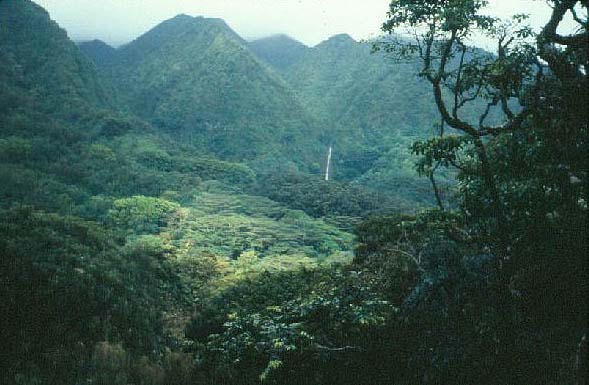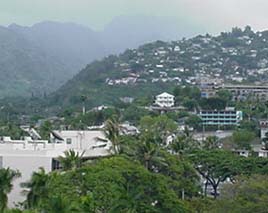 |
 |
 |
|||||||||||||||||||||
|
|
|
|
|
|
|
|
|
||||||||||||||||
|
|
|||||||||||||||||||||||
|
|
|
|
Manoa Valley, Waikiki ahupua‘a.
|
|
|
|
Much of the history of O‘ahu prior to the conquest of Kamehameha has been buried by time and by external forces. Jim Bartels tells us about O‘ahu traditions, and the years just prior to Kamehameha's conquest, when Kalanikupule was king of O‘ahu: "Sadly, by the time Kalanikupule lives here, this island has been devastated by the great battle, and the great war, that happened in the 1780s, that destroyed the old, ancient O‘ahu royal families and their governing structure. O‘ahu, which was powerful and rich, was pretty much destroyed before Kalanikupule got here. "And then Kalanikupule fights another disastrous, pointless battle before Kamehameha comes, that furthers the decline of this place. So it was just a skeleton of what it had once been on the day Kamehameha landed." How did this happen? Listen:
|
|
|
|
||
| "The most civilized kings, the paragon kings, lived here on O‘ahu. In very, very ancient times, long before Umi lived, Ma‘ilikukahi lived in the center of this island in a place only vaguely known. He was the quintessential Hawaiian king, the 'King Arthur' of Hawai‘i, in that he was the good king. He took care of people, he took care of the gods, the land prospered, people prospered, many babies are born; he treated the commoners well. "It’s widely believed that on O‘ahu and on Kaua‘i the ordinary people had a much better life than they did on the Southern islands. Even in Hawai‘i, Moloka‘i, Maui, their lot was far better than we were led to believe in the old order. But on O‘ahu, they were even happier."
|
||
|
||
|
"The ali‘i families that grew up in these northern islands -- O‘ahu, Kaua‘i -- are the most ancient. Of course, every ali‘i lineage is ancient, and to us the differences would be very minor, but it’s the northern kingdoms that produce the great bloodlines that everyone wants to graft into, including Kamehameha. Theirs is the bluest blood, and the kingdoms they created, while very much like the kingdoms that Kamehameha’s grandparents and parents were creating, were a slightly different culture. "A large percentage of what we consider ancient Hawaiian is ancient Big Island transposed on the other islands. So we have only glimpses of beautiful things that were different. "It’s a wonderful story, of the ending of old O‘ahu. The ancient order gets involved in the period of warfare as the old kings of the different islands look to conquer their universe. By the late 1600s great kings are emerging. "Finally, about 20 or so years before Captain Cook, the old king of O‘ahu has kind of a ne'er-do-well son. So they pretty much vote him out. Then they go to this king’s nephew, who is again a paragon. His name is Kahahana. He is of the old O‘ahu stock, but he’s living on Maui with his uncle Kahekili. Kahekili is the person who everyone thinks will conquer all the islands. He never quite makes it."
|
|
|
|
"A delegation is sent from O‘ahu to ask this young prince to occupy the throne of his ancestors. This man has everything -- all the good qualities you’d expect. He agrees, but his wily uncle Kahekili said, “I’ll release you from my court. Just give me a souvenir of your island, just give me one small piece of land, just to show that you love me. Just a little tiny beach. All I want is the beach at Kualoa.” "And so this young man says 'Sure.' And he sails off with his gorgeous wife, comes to O‘ahu, and they establish a kingdom, and everything is going fine, until he has his council of chiefs. He’s setting up his government and he says, 'Oh yes, by the way, I gave my uncle one little piece of land just to show him that I loved him,' and they said 'What piece of land?' and he said 'Kualoa.' And they said 'Oh!' "Kualoa is where the whale ivory drifts ashore, and so whoever owns Kualoa is instantly king of Oahu. This is really Shakespearian! The great kahuna, Ka‘opulupulu, then advises Kahahana how to get out of this bargain. But Kahekili then knows that the only way he’s going to get O‘ahu is to kill this kahuna. "Then Kahahana begins to rule badly. Kahekili hires the brother of this great kahuna, who is also a great kahuna, and who knows all of Ka‘opulupulu’s tricks, and so they are able poison the king’s mind against Ka‘opulupulu. In a long, wonderful epic, almost up to the level of the Pele cycle but much later, Ka‘opulupulu tries to reason with Kahahana on another matter. Kahahana doesn’t listen to him, so Ka‘opulupulu tattoos his own knee, which gives Nanakuli its name in Hawaiian poetry" (kuli means both "knee" and "deaf").
|
|
"Eventually the kahuna Ka‘opulupulu is killed, and Kahekili realizes that his nephew is no longer smart enough to outwit him. Kahekili attacks -- lands his canoes in Waikiki, which is where Kamehameha is going to land his canoes 12 or 13 years later. We’re now up to about 1783. And the armies come marching over. Kahahana is at Kawananakoa in Nu‘uanu (which is about where Kalanikupule is when Kamehameha arrives!), and that battle is called the Battle of Kaheiki. "The stream that comes down from Pauoa Valley, behind Punchbowl, used to be named Kaheiki down at the bottom. It’s now gone. There was fighting down here at Kahehuna, and the final defeat of the armies here in lower Nu‘uanu. Kahahana escapes, which is traditional -- the king always escapes, and he always goes through the forest, and is fed by his people. It takes Kahekili two years to find him, and then finally Kahahana is found and killed. A marvelous 290-line chant is created, which is beautiful. And then he is sacrificed at the Waikiki heiau."
|
|
|
|
|
"Kahekili then takes over and settles in, and all would be well, except Kahahana’s father revolts a couple of years later, and assassinates one of Kahekili’s favorites. That so angers Kahekili that he kills every O‘ahu chief, and absolutely destroys any vestige of the old order. Just wipes everything out. So the O‘ahu is pretty thoroughly ravaged." "As if that’s not bad enough, Ka‘eo, father of Kaumuali‘i (the king of Kaua‘i), who is also from that same family as Kahekili, is fighting against Kamehameha as Kamehameha is moving down the islands. He rules Maui for a few years, and then decides he wants to make a visit home to Kaua‘i . He travels with this army to O‘ahu and he lands here for supplies. But Kalanikupule (son of Kahekili, who is ruling O‘ahu at this time) figures this must be an attack, so they get into several battles on the seashore. "Finally Ka‘eo and Kalanikupule make friends -- in typical ali‘i fashion, never mind how many soldiers have been killed. They fall into each others arms, rub noses, have a big lu‘au. And then Ka‘eo decides to march across the land and meet his canoes somewhere over towards Wai‘anae."
|
||
|
|
||
|
"As he’s marching along, he hears that some of his lieutenants have conspired to drown him at sea and take over his kingdom. He says, in very lordly fashion, 'Better I die on the field of battle, than be drowned like a dog.' So what does he do? Having just been given a great farewell party by Kalanikupule, he wheels his army around on the ‘Ewa plain and marshals for an attack. "Kalanikupule meets his army, and they have a devastating battle. Just
for no reason at all. And huge numbers are killed on all sides. They
probably had Western guns as well. This is the battle Kuki‘iahu,
which takes place at Pearl Harbor. Ka‘eo is killed; Kalanikupule
survives, but his army is wrecked. "Some of the voyagers that happened by at that time talk about this wasteland island, and how they have to go elsewhere for supplies. Earlier on, this was just considered the richest and most wonderful place."
|
|
|
|
|
|
"Meanwhile, guess who’s coming? Kamehameha, with John Young and all! So there is no way this poor island had a chance." Go to the next page to read the next chapter of this story, the Battle of Nu‘uanu.
|
||
|
|
||
| Language | Sources & Links
|
| |
|
|

|
| Nu‘uanu Home | Map Library | Site Map | Hawaiian Islands Home | Pacific Worlds Home |
|
|
|||
| Copyright 2003 Pacific Worlds & Associates • Usage Policy • Webmaster |
|||









